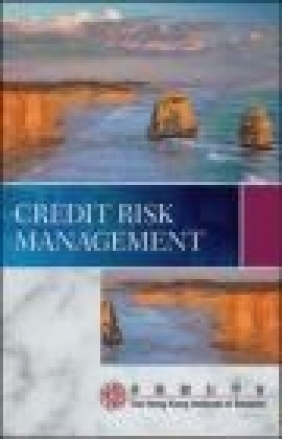Credit Risk Management
Credit Risk Management
- Producent: John Wiley
- Rok produkcji: 2014
- ISBN: 9780470827499
- Ilość stron: 528
- Oprawa: Miękka
Niedostępna
Opis: Credit Risk Management
The importance of managing credit and credit risks carefully and appropriately cannot be overestimated. The very success or failure of a bank and the banking industry in general may well depend on how credit risk is handled.§Banking professionals must be fully versed in the risks associated with credit operations and how to manage those risks. This up-to-date volume is an invaluable reference and study tool that delves deep into issues associated with credit risk management.§Credit Risk Management from the Hong Kong Institute of Bankers (HKIB)discusses the various ways through which banks manage risks. Essential for candidates studying for the HKIB Associateship Examination, it can also help those who want to acquire a deeper understanding of how and why banks make decisions and set up processes that lower their risk.§Topics covered in this book include:§Active credit portfolio management§Risk management, pricing, and capital adequacy§Capital requirements for banks§Approaches to credit risk management§Structural models and probability of default§Techniques to determine loss given default§Derivatives and structured productsPreface xi§PART 1 THE CREDIT RISK FRAMEWORK 1§1 Definitions and Concepts 3§Learning Objectives 3§Introduction 4§What is Credit? 4§Evolution of Credit Markets 7§What is Credit Risk? 10§Building Blocks of Portfolio Risk 14§Default 18§Portfolio Performance Metrics 19§Data and Data Systems 21§Risk Control Framework and Governance 22§2 Active Credit Portfolio Management 27§Learning Objectives 27§Introduction 28§What is ACPM? 28§Mark-to-market Approach 30§Metrics for ACPM 35§Data and Models 37§3 Capital Adequacy Framework 43§Learning Objectives 43§Introduction 44§Capital Adequacy Under Basel I 44§Basel II's Three Pillar Approach 49§Basel III (2010) 53§Capital Adequacy in Hong Kong 54§Implementation Issues 55§PART 2 CAPITAL REQUIREMENTS ON CREDIT RISK UNDER BASEL 59§4 Standardised Approach to Credit Risk 61§Learning Objectives 61§Introduction 62§Standardised Approach to Credit Risk 62§Individual Claims 63§Credit Risk Mitigation 74§Securitization Exposures 84§5 Internal Ratings-Based Approach 89§Learning Objectives 89§Introduction 90§What is the IRB Approach? 90§Building Blocks of the IRB Approaches 92§IRB and Selected Exposures 93§Internal Rating System 106§Validation of IRB Models 114§PART 3 CREDIT RISK AND PORTFOLIO MODELS 123§6 Structural Models 125§Learning Objectives 125§Introduction 126§Basic Structural Model 126§Black-Scholes-Merton 129§Valuation 133§Black-Cox 135§Vasicek-Kealhofer 140§Stochastic Interest Rates 144§Endogenous Default Barrier 145§Corporate Transaction Analysis 146§Liquidity 147§Other Structural Approaches 148§7 Econometric Models 159§Learning Objectives 159§Introduction 160§Discrete-choice Models 160§Hazard Rate (Duration) Models 168§Practical Applications 172§Calibrating Econometric Models 177§Calibrating to Ratings 187§Interpreting the Relative Infl uence of Factors in Econometric Models 192§Data Issues 194§8 Loss Given Default 203§Learning Objectives 203§Introduction 204§Timeline of Default Resolution 204§Measures of LGD 206§Multifactor Approach to LGD 212§Regression Framework 217§9 Reduced-form Models 223§Learning Objectives 223§Introduction 224§Reduced-form Models in Context 225§Basic Intensity Models 228§DSL Framework 237§Credit Rating Transition Models 241§Default Probability Density Version of Intensity Models 247§Generic Credit Curves 253§10 PD Model Validation 259§Learning Objectives 259§Introduction 260§Parameter Robustness 260§Measures of Model Power 263§Measures of PD Levels and Calibration 267§Sample Size and Confi dence Bounds 280§Assessing the Economic Value of More Powerful PD Models 296§Designing Validation Tests 305§11 Portfolio Models 315§Learning Objectives 315§Introduction 316§Measuring Portfolio Diversifi cation 316§Portfolio Risk Assuming No Credit Migration 317§Structural Models of Default Correlation 319§Credit Migration 323§Model of Value Correlation 325§Probability of Large Losses 329§Valuation 332§Return Calculations 334§Risk Calculations 337§Portfolio Loss Distribution 343§Capital 355§Economic Capital and Portfolio Management 358§Improving Portfolio Performance 361§Performance Metrics 364§Reduced-form Models and Portfolio Modelling 368§Correlation in Intensity Models 369§Copulas 371§Integrating Market and Credit Risk 373§Counterparty Risk in CDS and Credit Portfolios 374§Stress-testing 376§PART 4 CREDIT DERIVATIVES AND STRUCTURED CREDIT PRODUCTS 383§12 Credit Derivatives 385§Learning Objectives 385§Introduction 386§What are Credit Derivatives? 386§Credit Default Swap 389§Total Return Swaps 393§Credit-linked Notes 398§Credit Spread Derivatives 399§Pricing Credit Derivatives 401§13 Structured Credit Products 415§Learning Objectives 415§Introduction 416§Securitisation 416§Asset Backed Security 423§Collateralised Debt Obligation 424§Capital Charge Requirements 427§Derivatives and Structured Credit as Risk Management Tools 428§Summary 430§Key Terms 431§
Szczegóły: Credit Risk Management
Tytuł: Credit Risk Management
Producent: John Wiley
ISBN: 9780470827499
Rok produkcji: 2014
Ilość stron: 528
Oprawa: Miękka
Waga: 0.6 kg


















